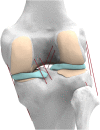Effect of geometric variations on tibiofemoral surface and post-cam design of normal knee kinematics restoration
- PMID: 30578465
- PMCID: PMC6303222
- DOI: 10.1186/s40634-018-0167-z
Effect of geometric variations on tibiofemoral surface and post-cam design of normal knee kinematics restoration
Abstract
Background: Restoration of natural knee kinematics for a designed mechanism in knee implants is required to achieve full knee function in total knee arthroplasty (TKA). In different posterior-stabilized TKAs, there are wide variations in tibiofemoral surfaces and post-cam design. However, it is not known whether these design variations preserve natural knee kinematics. The purpose of this study was to determine the most appropriate tibiofemoral surface and post-cam designs to restore natural knee kinematics of the TKA.
Methods: A subject-specific finite element knee modal was used to evaluate tibiofemoral surface and post-cam design. Three different posts in convex, straight, and concave geometries were considered with a fixed circular cam design in this study. In addition, this post-cam design was applied to three different surface conformities for conforming, medial pivot, and subject anatomy mimetic tibiofemoral surfaces. We evaluated the femoral rollback, internal-external rotation, and quadriceps muscle force under a deep-knee-bend condition.
Results: The three different tibiofemoral conformities showed that the convex post provided the most natural-knee-like femoral rollback. This was also observed in internal rotation. In surface conformity, subject anatomy mimetic tibiofemoral surfaces showed the most natural -knee-like kinematics and quadriceps force.
Conclusions: This study confirmed that convex post design and subject anatomy mimetic tibiofemoral surfaces provided the most natural-knee-like kinematics. This study suggested that post-cam design and tibiofemoral surface conformity should be considered in conventional and customized TKA.
Keywords: Conformity; Finite element analysis; Patient-specific implant; Post-cam design; Total knee arthroplasty.
Conflict of interest statement
Ethics approval and consent to participate
Approval was not required, as neither human participants nor animals were involved in this study.
Consent for publication
Not applicable
Competing interests
The authors declare that they have no competing interests.
Publisher’s Note
Springer Nature remains neutral with regard to jurisdictional claims in published maps and institutional affiliations.
Figures








Similar articles
-
Tibiofemoral conformity variation offers changed kinematics and wear performance of customized posterior-stabilized total knee arthroplasty.Knee Surg Sports Traumatol Arthrosc. 2019 Apr;27(4):1213-1223. doi: 10.1007/s00167-018-5045-9. Epub 2018 Jul 5. Knee Surg Sports Traumatol Arthrosc. 2019. PMID: 29974167
-
Effect of Post-Cam Design for Normal Knee Joint Kinematic, Ligament, and Quadriceps Force in Patient-Specific Posterior-Stabilized Total Knee Arthroplasty by Using Finite Element Analysis.Biomed Res Int. 2018 Sep 19;2018:2438980. doi: 10.1155/2018/2438980. eCollection 2018. Biomed Res Int. 2018. PMID: 30327775 Free PMC article.
-
Patient-specific design for articular surface conformity to preserve normal knee mechanics in posterior stabilized total knee arthroplasty.Biomed Mater Eng. 2018;29(4):401-414. doi: 10.3233/BME-180998. Biomed Mater Eng. 2018. PMID: 30282339
-
How prosthetic design influences knee kinematics: a narrative review of tibiofemoral kinematics of healthy and joint-replaced knees.Expert Rev Med Devices. 2019 Feb;16(2):119-133. doi: 10.1080/17434440.2019.1564037. Epub 2019 Jan 4. Expert Rev Med Devices. 2019. PMID: 30608000 Review.
-
Tibiofemoral wear in standard and non-standard squat: implication for total knee arthroplasty.Muscles Ligaments Tendons J. 2018 Apr 16;7(4):520-528. doi: 10.11138/mltj/2017.7.4.520. eCollection 2017 Oct-Dec. Muscles Ligaments Tendons J. 2018. PMID: 29721453 Free PMC article. Review.
Cited by
-
Posterior-stabilized total knee arthroplasty kinematics and joint laxity: A hybrid biomechanical study.Arthroplasty. 2022 Dec 15;4(1):53. doi: 10.1186/s42836-022-00153-4. Arthroplasty. 2022. PMID: 36522686 Free PMC article.
-
Change in knee biomechanics during squat and walking induced by a modification in TKA size.J Orthop. 2020 Oct 8;22:463-472. doi: 10.1016/j.jor.2020.10.006. eCollection 2020 Nov-Dec. J Orthop. 2020. PMID: 33093756 Free PMC article.
-
Biomechanical and Clinical Effect of Patient-Specific or Customized Knee Implants: A Review.J Clin Med. 2020 May 21;9(5):1559. doi: 10.3390/jcm9051559. J Clin Med. 2020. PMID: 32455733 Free PMC article. Review.
-
Minimal clinically important difference (MCID), substantial clinical benefit (SCB), and patient-acceptable symptom state (PASS) in patients who have undergone total knee arthroplasty: a systematic review.Knee Surg Relat Res. 2024 Jan 11;36(1):3. doi: 10.1186/s43019-024-00210-z. Knee Surg Relat Res. 2024. PMID: 38212863 Free PMC article. Review.
-
Loading on Attune® fixed-bearing cruciate-substituting total knee implant in knee malalignment during activities of daily living: A finite element analysis.J Orthop. 2021 Jul 12;26:36-41. doi: 10.1016/j.jor.2021.07.002. eCollection 2021 Jul-Aug. J Orthop. 2021. PMID: 34290486 Free PMC article.
References
-
- Arnout N, Vanlommel L, Vanlommel J, Luyckx JP, Labey L, Innocenti B, Bellemans J. Post-cam mechanics and tibiofemoral kinematics: a dynamic in vitro analysis of eight posterior-stabilized total knee designs. Knee Surg Sports Traumatol Arthrosc. 2015;23(11):3343–3353. doi: 10.1007/s00167-014-3167-2. - DOI - PubMed
-
- Banks S, Bellemans J, Nozaki H, Whiteside LA, Harman M, Hodge WA (2003) Knee motions during maximum flexion in fixed and mobile-bearing arthroplasties. Clin Orthop Relat Res (410):131–138. 10.1097/01.blo.0000063121.39522.19 - PubMed
LinkOut - more resources
Full Text Sources

